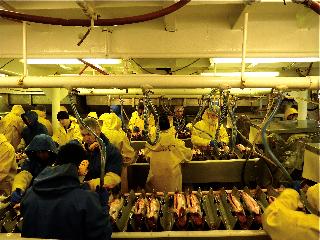Why Foreign Students are Hired for Alaskan Fish Processing Jobs
Processing fish at Snopac Products (photo: Nancy Blakey, co-owner of Snopac)
By Daysha Eaton of KDLG
At the dock at the Sno-Pac fish processing plant in Dillingham, Alaska, boats deliver thousands of salmon per day. American college students used to stand along these assembly lines. But now, you’re more likely to hear people speaking Russian, Spanish or Chinese.
Here in Bristol Bay, globalization has transformed fish processing plants over the last couple of decades. Most of the workers now are foreign students, on J-1student visas, designed for cultural exchange and training.
Many people probably wouldn’t put fish gutting into those categories, but the workers are allowed in under the work-travel option of the visa.
Mache Kazubovsky, a student at the University of Warsaw in Poland, said he paid around $3,000 to a recruiting agent to set him up with the job at Sno-pac. When the salmon are running, Kazubovsky works 16-hours a day with time-and-a-half for overtime. He earned minimum wage, but his room and board are covered. Kazubovsky hopes to double his initial investment, and then take a cross-country trip.
Another worker here is Hoy-Juhw, from Mainland China. She is studying applied linguistics back home and plans to be a teacher. Like Kazubovsky, she’s here to travel.
“I want to see New York and Washington, DC, the most famous cities, everyone has to see,” Hoy-Juhw said. “Most of all I want to experience what is real American life. I mean, not the one in a factory in Alaska, but the real American life on the mainland, in the big cities.”
The J-1 student workers have been a godsend for Nancy Blakey, co-owner of Sno-Pac.
“They’re educated, they’re bright, and they’re working really hard, long hours,” Blakey said.
Alaska fish processors started hiring J-1 students in the 1990s when unemployment was low and they couldn’t find American workers. The J-1″²s are not just hard workers, Blakey said; they’re also really interesting.
“We had a young man come through who was studying nuclear physics. And we were talking, and he loved the beauty of nuclear physics. He was passionate and he was explaining it to me, in his limited English and doing very well. And he was going to be going out to gut fish. I think that’s pretty fantastic!”
Brad Gillespy does not think the J-1 program is fantastic. He’s regional manager for the Alaska Department of Labor in Anchorage.
“It just doesn’t appear to me the program is working the way it was intended,” Gillespy said. “If it is working the way it was intended, it’s having a negative impact on US and Alaska workers. If you’re in a rural community that’s got a plant or two and that’s one of the major employers there and they’re bringing in all outside workers, there’s got to be an impact on those individuals not being able to get on at those plants.”
Blakey said Sno-Pac has hireed locals for skilled positions, like truck drivers and heavy machinery operators, but few locals apply for the jobs that the J-1″²s do. Sno-Pac also recruits on a website aimed at American college students. But she said she doesn’t get many responses.
Back at the plant, Alexander Esbinoff, from Ukraine, who’s back for his second year, told me this year he has a new job, working in the laundry.
In Esbinoff”s mind, he’s moving up, which is something he said is hard for a college kid to do in Ukraine.
“In summer in my country we just party, drink and smoke and that’s all,” Esbinoff said. “Here you can work up to the scale you are, I can earn money and I can improve my knowledge.”
Esbinoff hopes to clear $8,000 this summer and then take a trip to Hawaii before heading home to Kiev to finish his degree. But he’s thinking of coming back for a third season next year.
